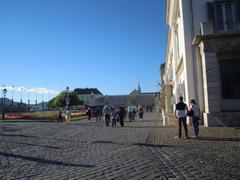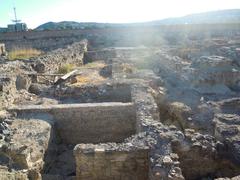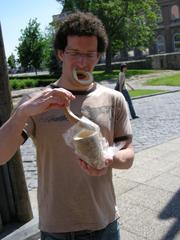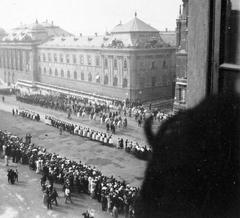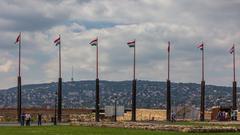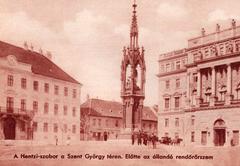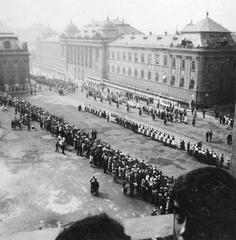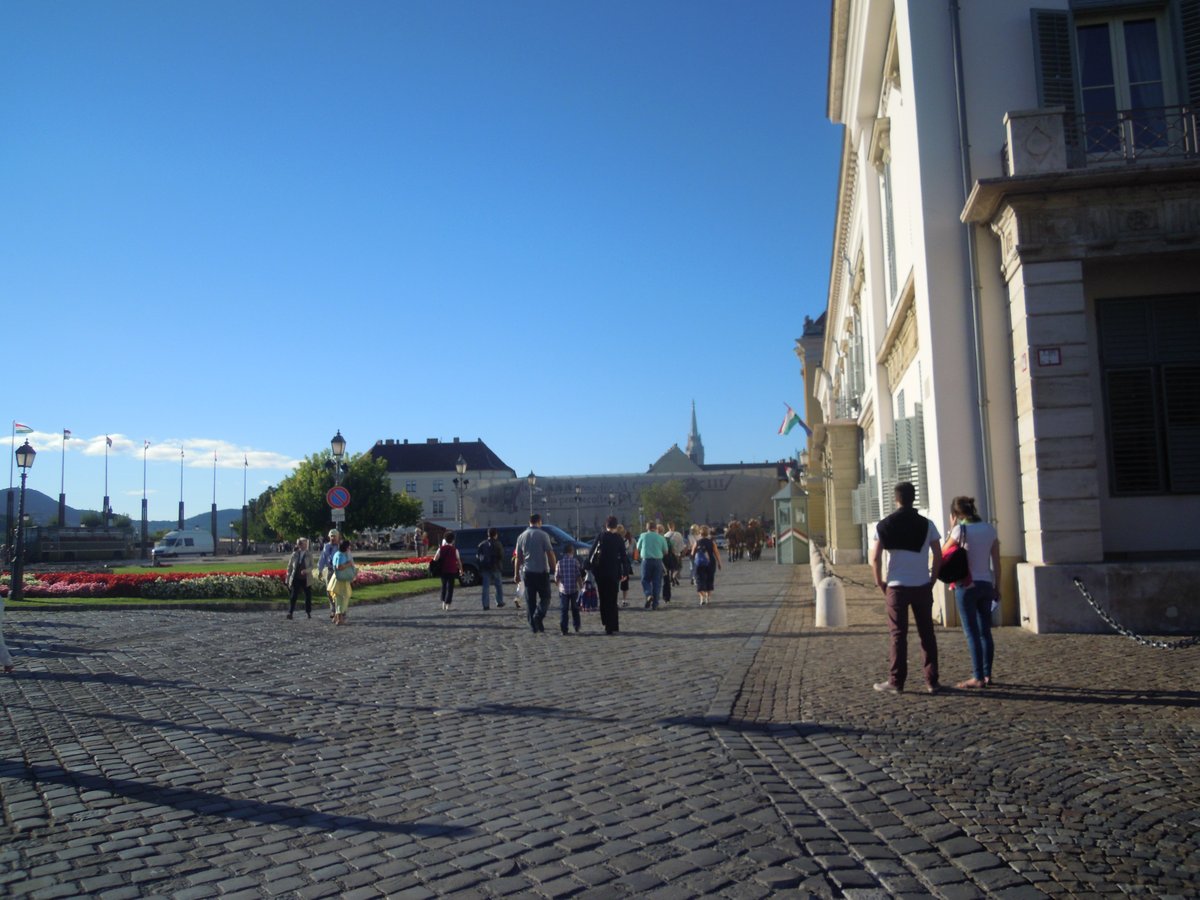
Szent György Square Budapest: Visiting Hours, Tickets, and Comprehensive Guide
Date: 15/06/2025
Introduction
Szent György Square (Saint George’s Square), nestled in the heart of the Buda Castle District, is one of Budapest’s most historically significant and visually stunning locations. Seamlessly blending medieval heritage with Baroque and Neoclassical architecture, the square offers visitors a window into centuries of royal tradition, political milestones, and vibrant cultural life. Panoramic views over the Danube and Pest, a lineup of architectural gems, and a year-round calendar of events make Szent György Square a must-see for anyone exploring the Hungarian capital (hu.wikipedia.org; budacastle.hu).
Historical Overview
Medieval Beginnings
Originally a network of densely built medieval streets, the area was transformed into an open square after the recapture of Buda from Ottoman occupation in 1686 (budavar.abtk.hu). The devastation of war and subsequent Austrian urban planning brought about the spacious Baroque ambiance that defines the square today.
Political and Ceremonial Importance
Over the centuries, Szent György Square has been the backdrop for pivotal events:
- 1457: Execution of László Hunyadi, a moment that reshaped Hungarian politics.
- 1514: Proclamation of a papal bull by Archbishop Tamás Bakócz, igniting the great peasant uprising led by György Dózsa.
- Coronation Ceremonies: Site of King Charles IV’s coronation, marking the end of Habsburg rule in Hungary (welovebudapest.com; epstudio.hu).
Ottoman and Habsburg Periods
The Ottoman occupation (1541–1686) led to the destruction of much of the square. After the Habsburg reconquest, Baroque and Neoclassical residences and ceremonial spaces emerged, including the Sándor Palace and the Castle Theatre (travelguidebudapest.com).
Modern Era and Restoration
World War II and the Communist period brought devastation and neglect, but since the 2000s, extensive renovations—particularly under the National Hauszmann Program—have restored the square’s buildings and monuments. Today, Szent György Square is once again a symbol of Hungarian national identity and governmental authority (hu.wikipedia.org; hungarianconservative.com).
Architectural and Cultural Highlights
Sándor Palace
A prime example of Neoclassical architecture, Sándor Palace serves as the official residence of Hungary’s President. Its elegant façade and stately interiors (open to visitors only on select days) reflect the square’s ongoing role in national governance (budacastle.hu).
Habsburg Gate and Turul Statue
The ornate Habsburg Gate, with ironwork by Gyula Jungfer and crowned by Gyula Donáth’s monumental bronze Turul statue, marks the ceremonial entrance to the Royal Palace gardens. The Turul, a mythical bird, is a powerful symbol of Hungarian identity (pestbuda.hu).
Castle Theatre (Várszínház)
Once a Carmelite convent, the Castle Theatre was the site of the first Hungarian-language stage performance in 1790. Today, it houses the Prime Minister’s Office and remains a symbol of Hungarian cultural life (travelguidebudapest.com).
Royal Stables Ruins
Recently opened to the public, these ruins provide a unique glimpse into Buda Castle’s layered past, enhanced by interpretive signage (pestbuda.hu).
Monuments and Memorials
The Honvéd monument commemorates the 1849 recapture of Buda and serves as a national symbol and meeting point (welovebudapest.com).
Visiting Szent György Square: Practical Information
Opening Hours
- Square Access: Open 24/7, year-round, free of charge.
- Museums & Attractions: Most, including the Hungarian National Gallery and Budapest History Museum, are open 10:00–18:00, closed Mondays. Check official websites for up-to-date hours.
Tickets
- Square: No ticket required.
- Museums: Admission prices generally range from 1500–3500 HUF. Tickets can be purchased online or on-site; booking ahead is advised during peak seasons (budapest.hu).
Guided Tours
- Walking tours of the Buda Castle District frequently include Szent György Square. Book in advance via official Budapest tourism sites or reputable operators.
Accessibility
- The square and its main routes are wheelchair accessible, aided by recent renovations. The funicular and accessible buses provide alternatives for those with mobility challenges.
Getting There
- Funicular: The Buda Castle Funicular provides a quick, scenic ascent from the Chain Bridge.
- Bus: Lines 16 and 16A from Deák Ferenc tér or Széll Kálmán tér.
- On Foot: Walking up Castle Hill is rewarding for those able to navigate cobblestone streets (budapest.yourcityvisit.com).
Travel Tips and Highlights
- Best Time to Visit: Early morning or late afternoon offers optimal lighting and fewer crowds.
- Currency: Hungarian Forint (HUF) is the official currency. Credit cards are widely accepted; carry cash for markets (triptobudapest.hu).
- Language: Hungarian is official; English is commonly spoken in tourist areas.
- Safety: Budapest is generally safe; exercise caution in crowded areas.
- Facilities: Public restrooms and water fountains are available; ample shaded benches enhance comfort.
- Photography: The square provides superb vantage points for panoramic shots of Budapest.
- Dining: The surrounding Castle District offers diverse eateries; food stalls operate during festivals.
- Events: The annual St. George’s Day Fair each April offers music, crafts, and family-friendly activities (csodalatosmagyarorszag.hu).
Nearby Attractions
- Buda Castle & Hungarian National Gallery: A short walk from the square, these offer world-class art and history exhibitions.
- Matthias Church & Fisherman’s Bastion: Iconic landmarks with breathtaking city views.
- Castle Hill Funicular: A historic, scenic ride to and from the Danube promenade.
Frequently Asked Questions (FAQ)
Q: What are the visiting hours for Szent György Square?
A: Open 24/7 as an outdoor space. Museums are usually open 10:00–18:00.
Q: Is there an entrance fee?
A: No, the square itself is free. Museum and gallery entries require tickets.
Q: Are guided tours available?
A: Yes, many walking tours cover Szent György Square and Buda Castle.
Q: Is the square accessible for wheelchairs?
A: Yes, recent renovations have improved accessibility.
Q: What is the best way to reach the square?
A: By funicular, bus, or walking up Castle Hill.
Visuals and Media Recommendations
- Images: Capture the Sándor Palace, Habsburg Gate, Turul statue, Royal Stables ruins, and panoramic city views.
- Virtual Tours: Many official sites offer interactive maps and virtual visits.
- Alt Tags: Use descriptive alt text like “Szent György Square with Sándor Palace in Budapest” or “Historic Honvéd monument at Szent György Square” for accessibility and SEO.
Conclusion and Call to Action
Szent György Square epitomizes Budapest’s blend of royal heritage, architectural splendor, and vibrant cultural life. With free year-round access, a host of nearby attractions, and an engaging calendar of events, it offers something for every visitor. Plan your trip using the practical tips above, and immerse yourself in the rich history and modern vibrancy of this iconic square.
For more information and real-time updates, visit the Budapest Castle District official website, and check Budapest tourism for museum details and event listings. For curated audio guides and interactive experiences, download the Audiala mobile app and follow our channels for the latest travel inspiration.
References
- Szent György Square Budapest: History, Visiting Hours, and Travel Tips, 2025
- Szent György Square Budapest: Architectural Highlights and Visitor Guide, 2025
- Visiting Szent György Square: History, Tickets, Hours & Travel Tips for Budapest’s Historic Landmark, 2025
- Szent György Square Visiting Hours, Tickets, and Tips for Exploring Budapest’s Historic Castle District, 2025
- Sándor Palace Official Site, 2025
